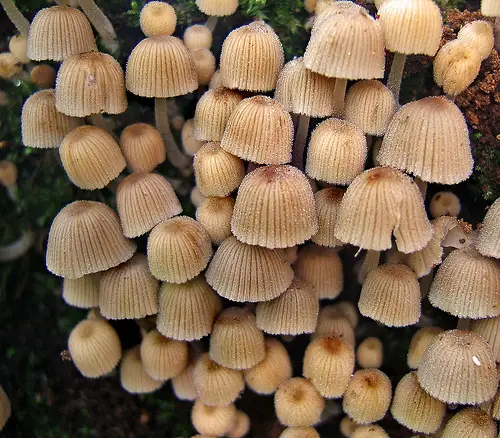Mica Cap
Also known as the glistening inky cap or the shiny cap, the mica cap is a commonly found species of fungus that has be found in cosmopolitan areas. These mushrooms are small and thin, but they are rather bountiful and usually grow in dense clusters. The mica cap is edible, but only immediately after plucking it from the ground. The reason for this is that the gills will slowly dissolve into a black and inky liquid which will basically automatically ‘destroy’ the mushroom. However, cooking will help stop this process of ‘autodigestion’ or ‘deliquescence’.
The mica cap was first illustrated by Carlus Lusius, who was a Botanist from the 16th century who created a woodcut of it. It is also the first published monograph fungi, as it was published in the History of Rare Plants (or Rariorum plantarum historia. Fungorum in Pannoniis observatorum brevis historia) in 1601.
The mushroom cap is small, at only 1 to 2.5 cm in diameter. Its cap shape can be either cylindrical or oval, but this will then expand to become bell-shaped and sometimes the cap is umbo shaped, which means that it has a central nipple-like protrusion. After this, it will then flatten becoming convex. When it is expanded, the diameter of the cap will reach only 0.8 – 3.0 cm. The ends or margin of the cap will then turn upwards slightly. The cap of the mushroom is yellow-brown or tan. In the centre, it will get darker. When the cap is younger, its surface is covered with white shiny particles, which are actually remnants of the universal veil that covers immature fungi specimens. However, these particles are easily washed away as they are loose, so older specimens will actually look rather smooth. Like some mushrooms, it is hygrophanous. This means that the cap will have a different colour, depending on how hydrated the fungus is.
The gills of the mica cap are crowded close to each other. They are initially white, but then get darker as the mushroom spores mature. Its stem is brittle yet hollow, and is about 4 – 10 cm tall and less than 0.5 cm thick. It is white, but it can discolour as it ages.
As mentioned above, the mica cap is an edible species. It requires cooking within 1 hour after collection, so it is great for those who are camping or staying in a nearby cottage and want some truly fresh ingredients to add to their food. The mica cap is considered as an ideal for omelettes and a flavour for sauces. However, this fungus is rather delicate so it is easily spoiled by over cooking. According to scientific study, the mica cap has the highest concentration of potassium out of 34 various edible fungi species that were tested. This is close to 0.5 g of potassium per 1 kg of mushroom. However, because the species can bioaccumulate heavy metals such as lead and cadmium which are not good for human consumption, it is advised that mushroom collectors should not pick mica caps up from the roadside or any other collection site that may be exposed to or contain pollutants.




